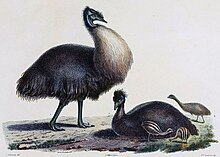Kangaroo Island Emu
| Kangaroo Island Emu | ||||||||||||
|---|---|---|---|---|---|---|---|---|---|---|---|---|

Kangaroo island emu (drawing in Lionel Walter Rothschild's work Extinct Birds (1907)) |
||||||||||||
| Systematics | ||||||||||||
|
||||||||||||
| Scientific name | ||||||||||||
| Dromaius novaehollandiae baudinianus | ||||||||||||
| Parker , 1984 |
The kangaroo island emu ( Dromaius novaehollandiae baudinianus ) is an extinct subspecies from the genus of the emus ( Dromaius ). The ratite was endemic to Kangaroo Island in South Australia . The species was extinct in 1836 at the latest.
description
The kangaroo island emu is known only from a few historical observations and from bones and egg remains. The species was even smaller than the black emu ( Dromaius ater ) endemic to King Island . Maybe he had a white chest. In the South Australian Museum in Adelaide a reconstruction of a Kangaroo Island emus was created.
Way of life
Almost nothing is known about the way of life. It is believed that the species lived in the forests in the interior of the islands. Apparently, however, she also went to beaches and adjacent sand dunes - especially in the evening - to drink in places with fresh water. The quite common animal lived in groups.
History of discovery and systematics

The kangaroo island emu was only described as a separate species in 1984. Today the kangaroo island emu is listed as a subspecies of the emus ( Dromaius novaehollandiae ) by the International Ornithological Union .
die out
The last reliable evidence was made in 1819. The species was extinct in 1836 at the latest. Nicolas Baudin brought three animals to France from his expedition from 1800 to 1804 , one of which lived in Paris until 1822.
The information on possible causes of extinction is contradictory. The Department of Sustainability, Environment, Water, Population and Communities in Canberra suggests that the extinction could have been caused primarily by repeated slash and burn cuts to convert forest and scrub into pastureland; According to the sources cited there, the hunt played only a minor role in causing the decline. However, according to the IUCN , hunting was the leading cause of extinction; According to the IUCN, a settler systematically wiped out the species on the island.
In 1906, the Australian zoologist James Andrew Kershaw (1866-1946) visited Kangaroo Island, where he found several emu bones.
See also
literature
- Dromaius baudinianus in the endangered Red List species the IUCN 2010. Posted by: BirdLife International , 2008. Accessed April 4, 2011th
- BirdLife International (Ed.): Kangaroo Island Emu - BirdLife Species Factsheet . 2008 ( online version ).
- Chris Baxter: An Annotated List of the Birds of Kangaroo Island . Ed .: South Australia National Parks and Wildlife Service. Revised edition. 1995, ISBN 0-7308-0677-4 .
Web links
- Species profile on the website of the Australian Department of Sustainability, Environment, Water, Population and Communities
- Species profile on The Extinction website
Individual evidence
- ↑ a b c d e Species Profile and Threats Database. In: Department of Sustainability, Environment, Water, Population and Communities. Retrieved April 4, 2011 .
- ^ Paul F. Lawson: A reconstruction of the Kangaroo Island Emu (Dromaius diemenianus) . In: Records of the South Australian Museum . Volume 9, 1950, pp. 309-312 .
- ↑ BirdLife International: Kangaroo Island Emu - BirdLife Species Factsheet. 2008, accessed April 4, 2011 .
- ↑ Shane A. Parker: The extinct Kangaroo Island emu, a list of unrecognized species . In: Bulletin of the British Ornithologists' Club . No. 104 , 1984, pp. 19-22 .
- ^ IOC World Bird List: Ratites: Ostriches to Tinamous
- ↑ Dromaius baudinianus in the endangered Red List species the IUCN 2010. Posted by: BirdLife International , 2008. Accessed April 7 2011th
- ^ WB Spencer, JA Kershaw: A Collection of sub-fossil birds and marsupial remains from King Island, Bass Straits . Memoirs of the National Museum of Melbourne. 3, 1906: pp. 5-35.